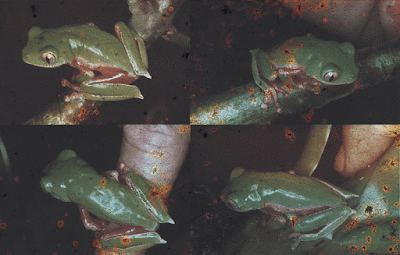 |
| Phrynomedusa dryade |
Abstract
We present the first taxonomic review of the genus Phrynomedusa since its description with diagnoses of the genus and species. We present a broad literature review of the genus and provide updates and remarks about the type series, tadpoles, calls, geographic distribution, and natural history of the species of Phrynomedusa. Additionally we describe a new species from município de São Luiz do Paraitinga, state of São Paulo, Brazil. Phrynomedusa dryade was initially identified as Phrynomedusa marginata; however, an integrated analysis of morphological and molecular characters enabled its recognition as a separate new species. For the first time, the advertisement call for one species of Phrynomedusa is described in detail. We describe the tadpole and present some field notes about the activity and biology of this new species.
Keywords: Atlantic Forest, Phrynomedusa dryade sp. nov., Tadpole, Taxonomy, Vocalization
Phrynomedusa Miranda-Ribeiro, 1923
Type species.— Phrynomedusa fimbriata Miranda-Ribeiro, 1923 (3–5), by monotypy.
• Phrynomedusa fimbriata Miranda-Ribeiro, 1923
• Phrynomedusa appendiculata (A. Lutz, 1925)
 |
| FIG. 4.— Live specimen of Phrynomedusa appendiculata from Paranapiacaba, município de Santo André , São Paulo, Brazil (Photos by Gualter Lutz, Gualter Lutz Slide Collection, MNRJ). |
• Phrynomedusa marginata Izecksohn and Cruz, 1976
• Phrynomedusa vanzolinii Cruz, 1991
• Phrynomedusa bokermanni Cruz, 1991
• Phrynomedusa dryade sp. nov.
Etymology.— The specific epithet ‘‘dryade’’ is in the genitive case and is derived from the Ancient Greek ‘‘dryas’’ (tree) and the suffix ‘‘ades’’ (from trees). The new name is a noun in apposition. In Greek mythology, dryads were the rare guardian deities of forests and woods. The German naturalist K.F.P. Martius (Martius et al. 1840) used the term ‘Dryads’ in the first phytogeographic division of Brazilian territory into five floristic regions, in which Dryads was the term used to refer to Atlantic Coastal Forest. The name of this new species refers to the occurrence of this beautiful Monkey Frog in the Atlantic Forest Domain.
Distribution.— Phrynomedusa dryade is known only from five localities in southeastern Brazil: four localities in state of São Paulo (municípios de Cananéia, Salesópolis, Itanhaém, and São Luiz do Paraitinga) and one locality in state of Rio de Janeiro (município de Paraty; Fig. 1).
Délio Baêta, Luís Olímpio Menta Giasson, José P. Pombal and Célio Fernando Baptista Haddad. 2016. Review of the Rare Genus Phrynomedusa Miranda-Ribeiro, 1923 (Anura: Phyllomedusidae) With Description of a New Species. Herpetological Monographs. 30(1); 49-78. DOI: 10.1655/HERPMONOGRAPHS-D-15-00009.1




